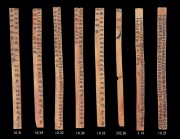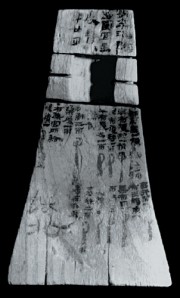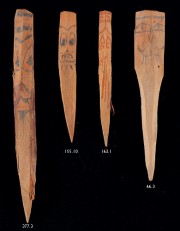|
Wang Kuo-wei, the great scholar of the late Ch'ing and early Republican period, called the discovery of inscribed wooden slips from the Han (206 B.C.-220 A.D.) and Ch'in (265-420) periods one of the four great academic discoveries of early-twentieth century China.The exhibition here displays more than 200 pieces from the Han period excavated around the area of Edsen-gol. Edsen-gol is located near the northwestern border of the Chinese empire in the Han dynasty. To strengthen security on the border, starting from Emperor Wu, the government had citizens moved near the frontier. Further, it set up outposts and public inns, and appointed troops all over the north and northwestern regions. The government also began to build roads connecting major cities in those regions. The majority of the populations in those regions were soldiers, poor farmers, criminals and nomadic people. Along with the expansion of the empire's military and political forces, the culture of the Han people gradually spread throughout the northwestern region.

|
Imperial Edict of 61 B.C.
Resource Identifier:H00035 (10.31), H00036 (332.26), H00037 (10.27), H00038 (5.10), H00039 (10.33), H00040 (10.30), H00041 (10.32), H00042 (10.29)
Resource Type:Materials: Wood
Description:This edict is dated to the fifth year of the Yuan-K'ang era of the Han period, that is, 61 B.C. Based on a system of monthly ritual observances, it orders the whole empire relight household fires, changing the type of firewood, before and during the summer solstice in that year. Attached at the end is the consecutive record of units copying and forwarding the order from the capital to the frontier region. Since the connecting strings have long since decomposed, the single strips had to be identified and put into correct sequence by modern scholars.
Format:Length 23.4-24.1 cm, width 1.5-1.8 cm.
Coverage:Site: A33 Ulan-durbeljin, Edsen-gol, Inner Mongolia |
| |
|
| |
|

|
Monthly and Seasonal Records of Military Supplies from the Kuang-ti South Platoon in the Yung-yüan Era
Resource Identifier:H00185 (128.1)
Resource Type:Materials: Wood
Description:This is the best-preserved and most complete wooden slip text extant, with the wooden pieces, strings, and ink all mostly intact. The slips are made with four lengths of strings and seventy-seven wooden slips. Other than two blank slips, the rest of the slips show five monthly and seasonal reports about the number and condition of the pots, mortars, crossbows, arrows, and other equipment of the two beacon stations --the P'o-hu and Ch'ien-shang beacon stations-- belonging to the Kuang-ti South Platoon. This set of wooden slips not only allows us to understand how the Han made wooden texts, but also what kind of equipment was available at the border and how it was regularly checked.
Format:Length 23.8 cm, width 91.0 cm
Coverage:Site: A27 Tsakhortei, Edsen-gol, Inner Mongolia |
| |
|
| |
|
 |
Inscribed Arrow Shaft
Resource Identifier:H04842 (164.1), H04845 (164.4), H04846 (164.5), H04850 (164.9)
Resource Type:Materials: Bamboo
Description:These are four of a collection of nine inscribed arrows. There were many similar pieces produced in the workshops of the Han dynasty. Each was inscribed with the date of production, name of the workshop (in this case the Honan workshop), the names of those responsible at each stage of production management, and the name and serial numbers of the workers.
Format:Length 29.7-33.0 cm, width 0.7-0.9 cm.
Coverage:Site: A33 Ulan-durbeljin, Edsen-gol, Inner Mongolia |
| |
|
| |
|


|
Wooden Tag for Bag containing Military Clothing
Resource Identifier:H00114 (8.2)
Resource Type:Materials: Wood
Description:The writing on this tag has faded over time and is now indistinguishable to the naked eye. Its traces can only be made out under infra-red light. The tag explains that the attached bag (now lost) contains both private and official clothing for a frontier guardsman from Huai-yang. After these clothes were placed in the bag it was closed with a rope that also secured this tag. Clay was then placed in the tag's mould onto the rope and impressed with a seal.
Format:Length 17.6, top width 4.7, base width 9.6 cm
Coverage:Site: A8 Mu-durbeljin, Edsen-gol, Inner Mongolia |
| |
|
| |
|

|
Wooden Talismans
Resource Identifier:H00052 (66.3), H00053 (155.10), H00054 (163.1), H00055 (377.3)
Resource Type:Materials: Wood
Description:The Han used these ferocious looking talismans to avoid evil spirits and hexes. The bottom of the talisman is sharp so it can be fitted onto the door.
Format:66.3:Length 21.5,width 3.6,thickness 1.76 cm.
155.10:Length 16.5,width 2.2,thickness 1.76 cm.
163.1:Length 17.1,width 1.8,thickness 0.86 cm.
377.3:Length 26.8,width 2.7,thickness 1.26 cm.
Coverage:Site: A35 Taralingin-durbeljin (66.3), A21/A22 Bukhen-torei (155.10/163.1), P9 Borotsonch (377.3), Edsen-gol, Inner Mongolia |
Text and images are provided by Institute of History and Philology, Academia Sinica
Digital Resources and Archived Images Application
|

















